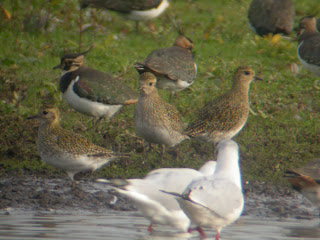Pick of the birds this morning was a winter plumaged Dunlin foraging on the back of the spit. It was too far off for a record shot, but came much closer this afternoon, but with worsening light, so the best of an awful bunch of record shots are here:
 |
| In focus, but bad angle Better angle - blurred! |
As I walked back to the car, I found a Coal Tit in the conifers near the cottages, which looked like it had a bird feeder seed in its beak - the first cottage has a handy set of bird feeders in the garden. Quite a scarce bird around the pits, so nice to see. I decided to walk the northern footpath today and came across a noisy flock of Siskins feeding in the alders - about 30 birds. I stopped on the wooden footbridge over the cut and after a few minutes caught a glimpse of a movement in the water. Through a thick tangle of branches I watched a lovely Water Rail wandering around probing for food - it's always nice to get a prolonged view of these secretive birds.
I paid a quick second visit to the pit this afternoon. The Dunlin was still present though much closer. At 2:55pm an adult Mediterranean Gull flew past my position on the west viewpoint and I watched it glide in and land just off the end of the spit. This enabled me to get another rubbish record shot - it was quite mobile in the water for about 5 minutes and then flew much further out to the east and landed in the middle of the lake. I presume that this is the same adult bird that has been reported fairly regularly, though it appears to be more advanced in getting its black hood than the bird I saw on the 18th January, but that was 2 weeks ago!
 |
| Roll on sunnier days when I can focus! |















